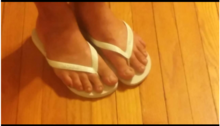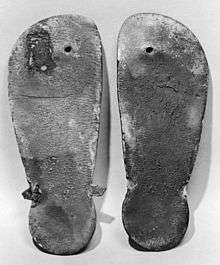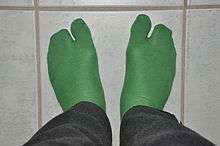Flip-flops
Flip-flops are a type of sandal, typically worn as a form of casual wear. They consist of a flat sole held loosely on the foot by a Y-shaped strap known as a toe thong that passes between the first and second toes and around both sides of the foot or can be a hard base with a strap across all the toes (these can also be called sliders or slides).

This style of footwear has been worn by the people of many cultures throughout the world, originating as early as the ancient Egyptians in 1,500 B.C.
In the United States the flip-flop descends from the Japanese zōri, which became popular after World War II as soldiers brought them back from Japan. They became popular unisex summer footwear[1] starting in the 1960s.
Etymology
The term flip-flop has been used in American and British English since the 1960s to describe the thong or no-heel-strap sandal. It is an onomatopoeia of the sound made by the sandals when walking in them.[2] They are called thongs (sometimes pluggers[3]) in Australia,[4] jandals (originally a trademarked name derived from "Japanese sandals") in New Zealand,[5] slops or “visplakkies” in South Africa[6] and Zimbabwe, and tsinelas or step-in in the Philippines (or, in some Visayan localities, "smagol", from the word smuggled).
Throughout the world, they are known by a variety of other names, including slippers in Hawaii, Bahamas, and Trinidad and Tobago.
In Russia, Ukraine and post-Soviet countries they are called vietnamki.[6][7][8]
History




Thong sandals have been worn for thousands of years, dating back to pictures of them in ancient Egyptian murals from 4,000 BC. A pair found in Europe was made of papyrus leaves and dated to be approximately 1,500 years old. These early versions of flip-flops were made from a wide variety of materials. Ancient Egyptian sandals were made from papyrus and palm leaves. The Maasai people of Africa made them out of rawhide. In India, they were made from wood. In China and Japan, rice straw was used. The leaves of the sisal plant were used to make twine for sandals in South America, while the natives of Mexico used the yucca plant.[9]
The Ancient Greeks and Romans wore versions of flip-flops as well. In Greek sandals, the toe strap was worn between the first and second toes, while Roman sandals had the strap between the second and third toes. These differ from the sandals worn by the Mesopotamians, with the strap between the third and fourth toes. In India, a related chappal ("toe knob") sandal was common, with no straps but a small knob sitting between the first and second toes. They are known as Padukas.[10]
The modern flip-flop became popular in the United States as soldiers returning from World War II brought Japanese zōri with them. It caught on in the 1950s during the postwar boom and after the end of hostilities of the Korean War. As they became adopted into American popular culture, the sandals were redesigned and changed into the bright colors that dominated 1950s design.[11] They quickly became popular due to their convenience and comfort, and were popular in beach-themed stores and as summer shoes.[12] During the 1960s, flip-flops became firmly associated with the beach lifestyle of California. As such, they were promoted as primarily a casual accessory, typically worn with shorts, bathing suits, or summer dresses. As they became more popular, some people started wearing them for dressier or more formal occasions.[10]
In 1962, Alpargatas marketed a version of flip-flops known as Havaianas in Brazil. By 2010, more than 150 million pairs of Havaianas were produced each year.[13] Flip-flops quickly became popular as casual footwear of young adults. Girls would often decorate their flip-flops with metallic finishes, charms, chains, beads, rhinestones, or other jewelry.[14] High-end flip-flops made of leather or sophisticated synthetic materials are commonly worn in place of sneakers or loafers as the standard, everyday article of casual footwear, particularly among teenagers and young adults, although it is not unusual to see older people wearing playful, thick-soled flip-flops in brilliant colors. Platform and high-heel variants began to appear in the 1990s.[15][16][17][18]
A minor controversy erupted in 2005 when some members of Northwestern University's national champion women's lacrosse team visited the White House wearing flip-flops. The team responded to critics by auctioning off their flip-flops on eBay, raising $1,653 USD for young cancer patient, Jaclyn Murphy of Hopewell Junction, New York, who was befriended by the team.[19] There is still a debate over whether this signaled a fundamental change in American culture — many youth feel that flip-flops are dressier and can be worn in a variety of social contexts, while older generations feel that wearing them at formal occasions signifies laziness and comfort over style.[10] In 2011, while vacationing in his native Hawaii, Barack Obama became the first President of the United States to be photographed wearing a pair of flip-flops.[20][21] The Dalai Lama of Tibet is also a frequent wearer of flip-flops and has met with several U.S. presidents, including George W. Bush and Barack Obama, while wearing the sandals.[22][23]
While exact sales figures for flip-flops are difficult to obtain due to the large number of stores and manufacturers involved, the Atlanta-based company Flip Flop Shops claimed that the shoes were responsible for a $20 billion industry in 2009. Furthermore, sales of flip-flops exceeded those of sneakers for the first time in 2006. If these figures are accurate, it is remarkable considering the low cost of most flip-flops.[24]
Design and custom

The modern flip-flop has a very simple design, consisting of a thin rubber sole with two straps running in a Y shape from the sides of the foot to the gap between the big toe and the one beside it. They typically do not have a strap around the heel, although heeled varieties are available, as well as flip-flops designed for sports, which come with added support common to athletic shoes, with the thong between the toes. Most modern flip-flops are inexpensive, costing as little as $5 USD, or less in some parts of the world.[10]
They are made from a wide variety of materials, as were the ancient thong sandals. The modern sandals are made of more modern materials, such as rubber, foam, plastic, leather, suede, and even fabric.[10] Thongs made of polyurethane have caused some environmental concerns; because polyurethane is a number 7 resin, they can't be easily discarded, and they persist in landfills for a very long time.[25] In response to these concerns, some companies have begun selling flip-flops made from recycled rubber, such as that from used bicycle tires, or even hemp,[26] and some offer a recycling program for used flip flops.[27]
Because of the strap between the toes, flip-flops are typically not worn with socks. In colder weather, however, some people wear flip-flops with toe socks.[28] The Japanese commonly wear tabi, a type of sock with a single slot for the thong, with their zōri.[29]
Health and medical implications and injuries
While flip-flops do provide the wearer with some mild protection from hazards on the ground, such as hot sand at the beach, glass, thumb tacks or even fungi and wart-causing viruses in locker rooms or community pools, their simple design is responsible for a host of other injuries of the foot and lower leg.[30]
Walking for long periods in flip-flops can be very tough on the feet, resulting in pain in the ankles, legs, and feet.[31] A 2009 study at Auburn University found that flip-flop wearers took shorter steps and their heels hit the ground with less vertical force than those wearing athletic shoes.[32][33][34] Individuals with flat feet or other foot issues are advised to wear a shoe with better support.[35]
The lack of support provided by thong sandals is thought by some to be a major cause of injuries. Some flip-flops have a spongy sole, causing the foot to roll further inward than normal when it hits the ground (over-pronation). Flip-flops can cause a person to overuse the tendons in their feet, resulting in tendonitis.[36]
Ankle sprains or broken bones are also common injuries, due to stepping off a curb or tumbling; the ankle bends, but the flip-flop neither holds on to nor supports it.[36] The straps of the flip-flop may cause frictional issues, such as rubbing, during walking. The open-toed nature of the thongs may result in cuts, scrapes, bruises, or stubbed toes.[37] Despite all of these issues, flip-flops do not have to be avoided completely. Many podiatrists recommend avoiding the inexpensive, drug store varieties and spending more on sandals with thick-cushioned soles, as well as ones that have a strap that's not canvas and that comes back almost to the ankle.[38]
See also
- Hnyat-phanat (Burmese)
- Sandal
- Slipper
References
- "How and When Flip Flops Become A Popular Unisex Summer Footwear". Free Earth. 15 March 2017. Archived from the original on 21 August 2019. Retrieved 19 Feb 2018.
- "Flip-Flop". Online Etymology Dictionary. Retrieved July 18, 2012.
- https://www.complex.com/pop-culture/2016/01/australian-men-out-drinking-stop-thieves-after-robbery-interview-video
- "IT Pro - Information Technology News & Reviews".
- "Morris Yock trademarks the jandal". New Zealand History. 4 October 1957. Retrieved 22 Feb 2017.
- Key, A.J. "Jandals, Thongs, Flip Flops & G-strings". Archived from the original on June 21, 2012. Retrieved July 18, 2012.
- Template:Newspaper caption
- Толковый словарь русской разговорной речи. Выпуск 1 (А-И). 1 (550 экз ed.). Москва: Языки славянской культуры. 2014. p. 286. ISBN 978-5-9905856-5-2.
- Kippen, Cameron (1999). The History of Footwear. Perth, Australia: Department of Podiatry, Curtin University of Technology.
- DeMello, Margo (2009). Feet and Footwear: A Cultural Encyclopedia. Santa Barbara, California: ABC-CLIO, LLC. pp. 130–131. ISBN 978-0-313-35714-5.
- "The History of Flip-Flops". Peche Blu. Archived from the original on January 4, 2013. Retrieved July 19, 2012.
- Cullen, Ed (2006). Letter in a Woodpile. Nashville, Tennessee: Cool Springs Press. ISBN 1591862493.
- Cain, Kathryn (July 30, 2010). "The Timeline: Flip-flops". The Independent. Retrieved July 19, 2012.
- Peterson, Amy T.; Kellogg, Ann T. (2008). The Greenwood Encyclopedia of Clothing Through American History 1900 to the Present. Westport, Connecticut: Greenwood Publishing Group. p. 372. ISBN 978-0-313-35855-5.
- Jessica Booth (2018-08-28). "What high heels looked like the year you were born". Insider.
- Lauren Alexis Fisher (2019-04-15). "Steve Madden Is Trying to Make Its '90s Platform Flip Flops Happen Again". Harper's Bazaar.
- Liana Satenstein (2018-03-26). "Thong Heels—Spring's Sexiest Sandals—Are Back". Vogue.
- Emily Kirkpatrick (2019-08-11). "High-heeled flip-flops are back". New York Post.
- Ward, Julie (September 13, 2005). "Next big step in team spirit: Flip-flops". USA Today. Retrieved July 19, 2012.
- "Appropriate? Obama Becomes First Flip-Flop President". Fox News. January 5, 2011. Retrieved July 19, 2012.
- Fermino, Jennifer; Hurt, Charles. (January 5, 2011). "That's quite a feet! Bam first flip-flop president". New York Post. Retrieved July 19, 2012.
- Lister, Richard (February 19, 2010). "Flip-flop diplomacy with the Dalai Lama". BBC News. Retrieved July 19, 2012.
- Weisman, Jonathan; Canaves, Skye (February 18, 2010). "Dalai Lama Meets With Obama". Wall Street Journal. Retrieved July 19, 2012.
- Bernhard, Blythe (June 18, 2009). "Flips-flops are bad for your sole". Seattle Times. Retrieved July 19, 2012.
- Bloch, Michael. "Recycling Flip-Flops". Green Living Tips. Retrieved July 19, 2012.
- Vasil, Adria (2007). Ecoholic: Your Guide to the Most Environmentally Friendly Information, Products and Services In Canada. Toronto: Random House Canada. ISBN 978-0-307-36613-9.
- "Flip-Flop Brigade". terracycle.com. Archived from the original on May 18, 2015. Retrieved May 31, 2015.
- Stoller, Debbie (2010). Stitch 'n Bitch Superstar Knitting: Go Beyond the Basics. New York City: Workman Publishing Company. p. 186. ISBN 978-0-7611-3597-5.
- Sosnoski, Daniel (1996). Flip-Flop BrigadeIntroduction to Japanese Culture. Boston, Massachusetts: Charles E. Tuttle Publishing Company. p. 85. ISBN 0-8048-2056-2.
- Csomor, Marina (July 18, 2012). "Flip-flops present feet with a painful problem". CNN. Retrieved July 19, 2012.
- Kam, Katherine. "Flip-Flops Fun but Beware of Foot Pain". WebMD. Retrieved 20 January 2017.
- Shroyer, JF; Weimar, WH (2010). "Comparative analysis of human gait while wearing thong-style flip-flops versus sneakers". Journal of the American Podiatric Medical Association. 100 (4): 251–7. PMID 20660875.
- Shroyer, Justin F.; Robinson, Leah E.; Weimar, Wendi (August 27, 2009). Influence of thong flip‐flops on running kinematics in preschoolers (PDF). Annual Meeting of the American Society of Biomechanics. Penn State University. Archived from the original (PDF) on May 22, 2013.
- Shroyer, Justin (September 9, 2009). Influence of Various Thong Style Flip-flops on Gait Kinematics and Lower Leg Electromyography (PhD Thesis). Auburn, Alabama: Auburn University. pp. 31–52. hdl:10415/1905.
- Willingham, Val (August 6, 2010). "Flip-flops aren't always easy on the feet". CNN. Retrieved July 19, 2012.
- Yara, Susan (May 4, 2006). "Skip the Flip-Flops". Forbes. Retrieved July 19, 2012.
- Watson, Nicole (July 18, 2012). "Study: Comfortable flip-flops causing painful health risks". ABC Action News. Archived from the original on August 14, 2012. Retrieved July 19, 2012.
- "Doctors Warn About Flip-Flops". Click2Houston.com. October 10, 2011. Retrieved July 19, 2012.